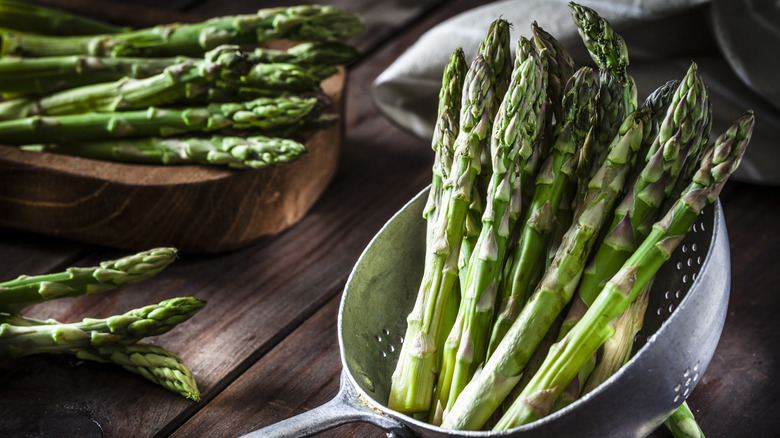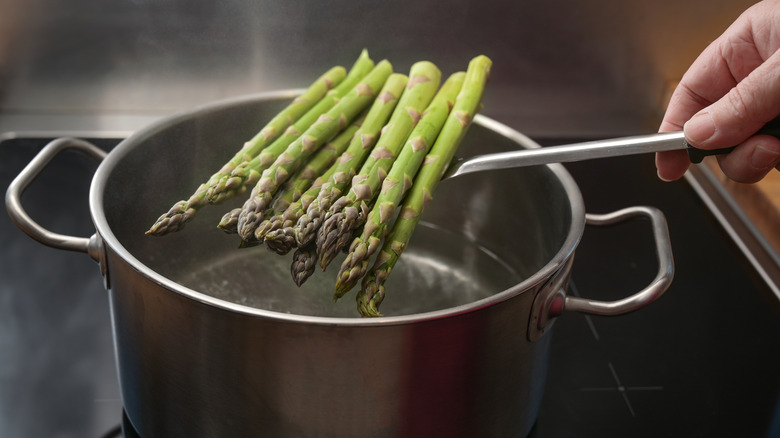You Should Probably Take More Time To Clean Asparagus
One of the best veggies for elevating warm weather fare is asparagus, but like leeks, its many folds and crevices can make cleaning a chore. The nice thing about asparagus is that you can wash it as soon as you bring it home, unlike other produce where extra moisture spells rot.
Take your fresh asparagus and remove any limp or wilted stalks. Then, remove the woody ends of the healthy stalks by taking one and finding the point where the end will easily snap off with your fingers. Line that spear next to the others as a measuring guide and cut the rest of the ends off with a knife. Now wash the spears under cold running water and remove the dirt clinging to your asparagus, and after cleaning, pat them dry with a paper towel. And in no time at all, you have asparagus that is mostly free of grime or pesticides, but there is a more efficient way to disinfect asparagus.
For extra clean asparagus, take the time to blanch it, which can help rid it of any bacteria as well as debris that may have evaded a rinse. Another advantage of cleaning asparagus this way is your spears will be more vibrant and crisp.
Benefits of blanching
Blanching is not only the most efficient way to clean an asparagus bunch; it also enhances the overall texture. Go ahead and get a pot of water boiling while you're removing any sub-par spears and lopping off the fibrous ends. When the water starts to bubble, add a generous amount of salt — about a cup per gallon of water. Once the water returns to a boil, start adding in the spears, taking care not to add too much at a time so the water maintains a boil.
In roughly 3 minutes, depending on the thickness, check them for doneness by poking the asparagus with a knife to see if they are tender-crisp. When they are, immediately transfer them to an ice bath to stop the cooking process. The extra pass through ice water will also serve as a bath for any residue.
Visually, you'll notice your asparagus has taken on a more vibrant color. That's because a gas resides between the skin of the asparagus and the pigment, and once released, that pigment rises to the surface. But the texture is where you'll really appreciate the blanch, as it will leave you with a crisper vegetable to work with when you add your clean asparagus to a dish.
Storing cleaned asparagus
If you aren't planning on using your asparagus immediately, you can pat it dry after shocking it in ice water and store it in an airtight container in the refrigerator. You will still want to use it fairly quickly as it will only stay at its best for 3 to 5 days. Within that time frame, your clean asparagus will keep its newly acquired bright green color and crisp texture.
If you don't think you'll be able to use it in a few days, freezing for future use is always an option. The best way to do this is to take the blanched asparagus and cut it up into bite-sized pieces. Spread the pieces onto a sheet pan and set them in the freezer until they become firm. After about an hour, the asparagus should be hard enough to transfer to a freezer-safe bag. Frozen asparagus lasts up to 6 months in the freezer, so you'll have plenty of time to think about how to use it.
Whether you freeze it, refrigerate it, or use it right away, blanching should be the first step to making the most out of this crunchy delicacy. You'll know that your produce is as clean as possible, and the crisp texture and vibrant color will add an extra layer of enjoyment as you highlight this summertime hero in your next meal.


